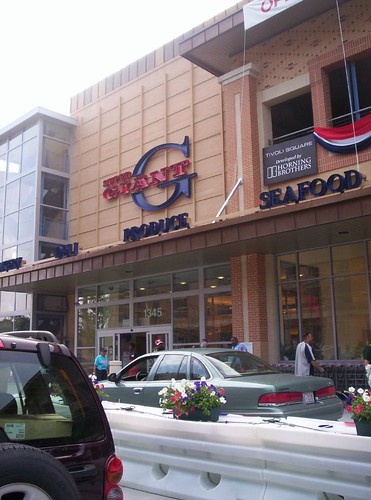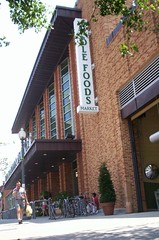More about chain vs. independent retail in the urban setting
Image: Whole Foods on P Street
There's a discussion on the Columbia Heights e-list about Whole Foods not being interested in the DC USA site, and that Ross Dress for Less is. I have put up a bunch of entries, this is one from the thread:
When I first moved to DC in Sept. 1987 I worked at 16th and P St. NW, although I lived in the NE quadrant. So I have been familiar with that area for some time.
For me, a committed urbanist, only a fool wouldn't have thought that the _land_ between 14th and 15th Streets on P Street was a good location, given its proximity to the high disposable income and large numbers of residents in the area west of 14th Street NW _and_ the lack of developable land inventory in the heart of Dupont Circle large enough to accommodate a supermarket, or other kinds of large footprint retail uses.
The two pieces I sent on urban store siting and chains have to do with the process generally, and with the process of how _chains_ think generally and how they think about urban locations. I have written voluminously about _the fact_ that most retail chains are not comfortable with urban locations, and this continues to be the case, and that the formats they bring to the city tend not to be urban appropriate.
The Giant at Tivoli Square is a perfect example. You can't get any more suburban than that location other than the lack of surface parking.

Giant Supermarket at Tivoli Square, when they had usurped public space for a "parcel pickup" which was a road built into the sidewalk. They were forced to give the sidewalk back.
Generally, Trader Joe's doesn't like east coast center city locations. To me, it'd be a no-brainer for them to locate across from Eastern Market or Downtown. They won't do it. If they hadn't received an incentive of $1.15 million to locate in Foggy Bottom, they wouldn't have located in DC. Whether they open more stores _in DC_ is still an open question.
cf. Joe Englert and H Street NE. He looks at areas and sees different things than the kind of people who run chain operations. His entry into H Street likely will make him millions and millions of dollars, just in real estate appreciation alone. He's not the kind of person who tends to be working for a commercial real estate broker or in the real estate division of large retail chains.
The reality is that there is a hierarchy of preferred locations within the city, and within each quadrant within the city when it comes to the store location metrics that _chains_ use to guide their investments.
In NW DC, I would aver that while it depends on the kind of business which shifts things around somewhat, it's likely that the ranking would be along these lines, with variances based on particular retail categories and companies within those categories:
Downtown
Georgetown
Friendship Heights
Dupont Circle
14th Street NW
Cleveland Park
Adams Morgan (i.e., Design Within Reach)
Columbia Heights
Foggy Bottom is an odd area. As far as retailers are concerned it is part Georgetown and part Dupont Circle, with a soupcon of Downtown.
And note that for national retail chains, for the most part, many suburban locations rank much higher than DC's seemingly best location, Downtown. The in-city location that really competes with suburban locations is Friendship Heights, and it's kinda suburban as it is, being on the border with Maryland, in a high income area, not too far from Bethesda.
Given the size of stores these days, It is rare for certain categories of retail chains to open locations within 1.5 miles of other stores, unless the population density is extremely high. This is why I've always thought that clamoring to land Whole Foods in Columbia Heights is for the most part a pipe dream.
Locating stores closer together was more typical when stores were smaller and most people shopped more locally. And it's still not the case in Manhattan, because for the most part supersized grocery stores are not possible due to land availability and price, plus the population density is intense. That's why smaller grocery stores, usually Gristedes or Waldbaums (A&P) and other small format stores, are found all over in areas of appealing demographics.
That kind of ranking is your reality. It gets worse when you consider the area I work in, Brookland. The overall city ranking is probably something like this:
Downtown
Georgetown/Friendship Heights
Dupont Circle
Rhode Island Avenue Metro Area (for bigger box stores)
14th Street NW
Cleveland Park/Adams Morgan (i.e., Design Within Reach)
Columbia Heights
Capitol Hill
H Street/Hechinger Mall
Places like Brookland, Takoma Park, Anacostia, etc. don't really rank, except with the retailers that truly think outside the box, i.e., Yes Grocery.
That's why I don't favor putting tons of city money into attracting chains, and I write way more than I sent to the list today about rebuilding the systems and structures that support the development of independent retail within the city.
Labels: retail, urban revitalization




0 Comments:
Post a Comment
<< Home